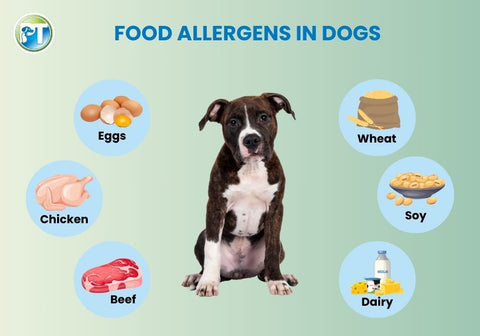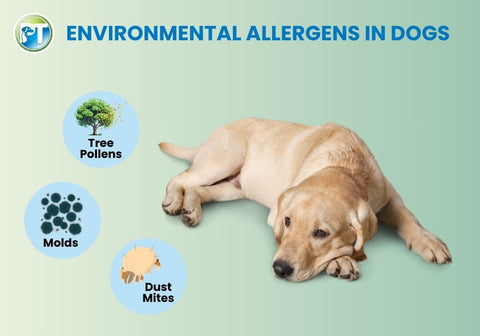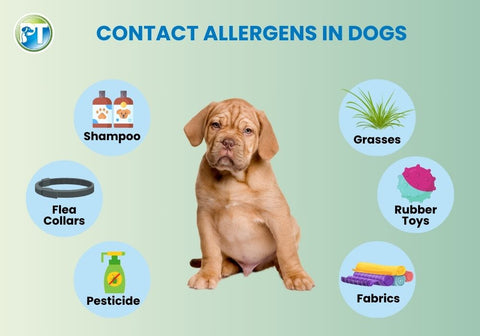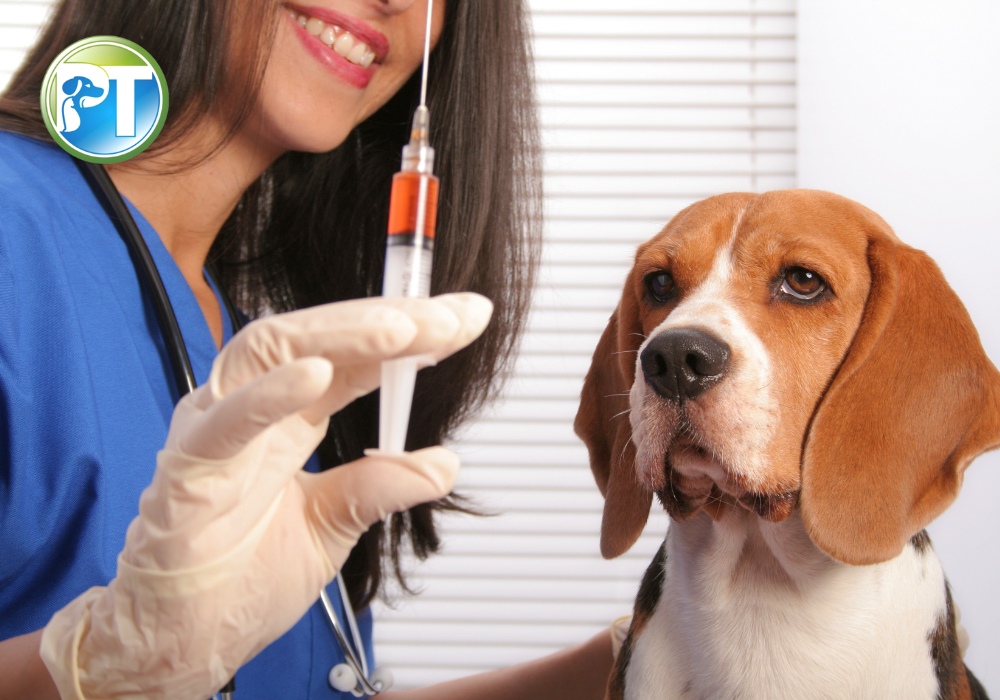How to Recognize and Treat Common Dog Allergies – Symptoms and Solutions

Have you ever noticed your furry friend scratching themselves furiously or sneezing a lot? They might just be dealing with some pesky allergies. Yes, just like us humans, dogs can get them, too.
Seeing our canine companions struggle with allergies is heartbreaking, and leaving them untreated can make them incredibly uncomfortable. In this blog, we’ll talk about dog allergies – what they are, how to recognize them, and how to help your pup overcome them.
Symptoms of Dog Allergies
How do you know if your dog is having an allergic reaction?
If your furry friend has allergies, you may notice some common symptoms. These may include:
-
Non-stop Scratching
If your dog can't seem to stop scratching, especially on their paws, ears, or under the belly, it might be a sign of allergies.
-
Red and Inflamed Skin
Check for hot spots and rashes or if your dog is licking a lot. These could indicate skin irritation due to allergies.
-
Sneezing and Sniffles
Keep an eye out for a runny nose, watery eyes, and even wheezing. These could be signs of allergies affecting their respiratory system.
-
Digestive Troubles
If your dog experiences upset stomach, vomiting, or diarrhea, it could be related to allergies.

Remember, dog allergy symptoms can vary depending on the cause and type of allergy. Some dogs may have mild symptoms, while others might face more serious reactions. If you think your dog has allergies, it's crucial to visit the vet for proper diagnosis and treatment.
Types of Allergies in Dogs and How to Treat Them
How would you know what your dog is allergic to?
Allergies in dogs can manifest in various ways, affecting their skin, digestion, and overall well-being. Knowing how to spot them is crucial for addressing your furry friend's discomfort.
Here are some common types:
1. Food Allergies
Food allergies are the most common type of pet allergy, affecting dogs who are sensitive to certain things they eat.
Common Allergens
While any food can potentially trigger an allergy, common culprits include proteins like eggs, chicken, beef, dairy products, soy, or grains. Dogs are not allergic to all foods but only to specific ones that trigger a reaction in their system.

Symptoms
Symptoms of food allergies can range from digestive issues, like vomiting and diarrhea, to skin problems like itching and excessive licking. They may also experience ear infections or even respiratory issues like wheezing. These signs typically occur after they ingest the food they're allergic to. However, it's important to note that the timing can vary and sometimes symptoms develop gradually.
Management and Treatment
If you suspect a food allergy, consult with your vet. Based on the severity of the allergy, they can then recommend a suitable hypoallergenic diet as the primary management strategy. Additionally, your vet may suggest additional treatments like antihistamines, fatty acid supplements, or probiotics to manage the symptoms.
The best way to identify the food allergen is to switch to an elimination diet trial. For this, you'll feed your dog a special diet with only a few ingredients for a while. Then, reintroduce other foods one by one gradually to identify which one causes itching or discomfort. Note any changes in their behavior or health. Ask your for proper guidance.
2. Flea Allergies
Fleas may seem like minor pests, but for dogs with flea allergies, their bites can trigger a full-blown allergic reaction.
Common Allergen
When we talk about flea allergies in dogs, we're not referring to the fleas themselves being allergens, but rather to their saliva. When a flea bites, it injects these proteins into your dog's skin. For allergic and sensitive pups, their immune system overreacts to these proteins, mistakenly considering them harmful invaders.

Symptoms
This overreaction leads to a condition called flea allergy dermatitis (FAD). The most common symptom is intense itching, often concentrated on the lower back, tail base, belly, and inner thighs. Your dog might scratch, chew, and lick themselves relentlessly, leading to hair loss and sore spots. They may also develop red and inflamed skin, sometimes with scabs or pustules.
Secondary Skin Infections
The constant itching and discomfort can lead to secondary skin infections in dogs. These open wounds, created by scratching, become breeding grounds for bacteria, leading to further complications. Hence, it is important to address the allergy promptly.
Management and Treatment
Here's a simple guide on how to handle flea allergies in dogs:
1. Consult Your Veterinarian
If you suspect your dog has flea allergies, head to your vet. They can recommend flea prevention methods, such as topical treatments, oral medications, or personalized flea collars. Additionally, they can guide you on a personalized grooming routine, covering practices like baths or shampoos.
2. Soothe Your Dog's Skin
Ease your dog's itchy skin by using shampoos or treatments recommended by your vet. Be mindful not to over-bathe your dog to maintain healthy skin.
3. Prevent Fleas at Home
Maintain a clean home by regular vacuuming, especially in areas your dog frequents. Wash your dog's bedding and toys with hot water to eliminate any potential fleas. Consult your vet for details on effective flea control products for your home.
Remember to treat all your pets for fleas, even if they seem unaffected. Keep a consistent cleaning routine to prevent re-infestation. Always consult your vet before trying new flea products to ensure your dog's well-being.
3. Environmental Allergies
Environmental allergies in dogs occur when they react to various elements in their surroundings. These elements can be present in the air, grass, or even in your home.
Common Allergens
- Pollen: Seasonal blooms from trees, weeds, flowers, and plants can be itchy culprits or trigger more serious reactions.
- Mold spores: Damp environments harbor these invisible irritants, leading to year-round allergy woes.
- Dust mites: These microscopic creatures live in bedding, furniture, and carpets, making indoor living a potential minefield for sensitive pups.

Symptoms
Your dog might exhibit excessive scratching, particularly on their paws, ears, or under the belly. Their skin may show signs of redness and irritation. Additionally, they might sneeze, similar to our response when dealing with a cold.
Management and Treatment
To manage environmental dog allergies, here are some common approaches:
1. Identify the Trigger
Seek professional guidance from your vet. They can conduct tests like skin testing or blood tests to identify specific allergens affecting your dog.
Maintain a detailed record of your dog's reactions and potential triggers. Note activities, seasonal changes, or exposure to new cleaning products that coincide with symptoms.
2. Manage Symptoms
Your vet may prescribe antihistamines, corticosteroids, or immunotherapy injections to control itchiness and inflammation.
3. Minimize Exposure
During high pollen seasons, consider brief walks or opt for air-conditioned spaces to minimize exposure. Improve indoor air quality by investing in HEPA filters for your home. These filters can help reduce airborne allergens that may be triggering reactions.
4. Remove Allergens at Home
Use vet-approved shampoos to eliminate allergens clinging to your dog's fur. Regular brushing can also help remove potential irritants. Wash items your dog frequently interacts with, such as bedding and toys, to ensure a thorough removal of allergens.
4. Contact Allergies
While not as common as other allergies, some pups can have contact allergies. This results from direct contact with certain allergens, like certain substances or materials.
Common Allergens
- Chemicals: Shampoos, cleaning products, fertilizers, and even certain fabrics can harbor allergens.
- Metals: Collars, leashes, and even jewelry worn by humans can cause reactions in sensitive pups.
- Plants: Some dogs react to specific plants like poison ivy, oak, or even certain types of grasses.
- Rubber: Toys and chew items made from rubber might trigger allergies in some dogs.

Symptoms
You might notice redness, a rash, or swelling at the points of contact. Sometimes, your pup might scratch or lick the area a lot. In severe cases, blisters or crusting may develop in the affected area.
Management and Treatment
Treating contact allergies in dogs involves identifying and minimizing exposure to the specific irritants causing the reaction. Here's a simple guide:
1. Identify the Allergen
Observe your dog's reactions and note potential triggers like new walks, wearing new collars, or using pet-safe shampoos. Work with your veterinarian to identify the specific allergen causing the contact allergy. This may involve allergy testing or a process of elimination.
2. Avoid Exposure to Allergens
Once the allergen is identified, take steps to minimize your dog's exposure. Adjust walks, switch pet products, or use protective barriers like booties.
3. Ease the Symptoms
Use vet-approved shampoos or topical treatments specifically designed for soothing irritated skin. Keep your dog hydrated to support healthy skin, and consider omega-3 fatty acid supplements for additional protection.
Remember, always follow your vet's recommendations for the most effective and tailored approach to treatment.
Conclusion
Remember, every pup is unique. While this guide helps you recognize signs and understand the basics, a vet visit is vital for an accurate diagnosis and tailored treatment plan.
Bonus Tip: Consider connecting with pet support groups online or in your community. Sharing experiences and tips with other pet owners can be a valuable source of support and information.
Frequently Asked Questions
-
How do you treat dog allergies?
Unfortunately, there's no one-size-fits-all answer for treating dog allergies. The exact approach depends on the type of allergy (food, flea, environmental, contact) and your dog's specific needs.
It’s better to consult with a veterinarian for an accurate diagnosis. Treatment may involve managing symptoms with medications like antihistamines or steroids, avoiding allergens, and, in some cases, desensitization through immunotherapy.
-
How can you test for food allergies in dogs at home?
To test for food allergies in dogs at home, try an elimination diet. Begin by selecting a novel protein and carbohydrate source that your dog has not consumed before. Feed only these ingredients for 8 to 12 weeks, keeping an eye on any changes in allergy symptoms. Slowly reintroduce one original ingredient at a time, and watch for adverse reactions.
While home observations can be helpful, nevertheless, a vet's expertise is crucial. Don't hesitate to schedule an appointment for a precise diagnosis and the best treatment plan for your dog.
-
What can I give my dog for itchy skin?
Common options for itchy skin in dogs include medicated oatmeal-based shampoos, antihistamines, or prescribed medications. Remember, your dog's well-being is the top priority, and a veterinarian is the best resource for proper diagnosis and treatment.
You might also enjoy...
-
Posted in
Pet Health


